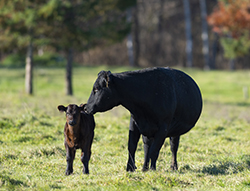New intranasal vaccine leads the way in early protection
By Chris Schneider, DVM, MS, Livestock Technical Services, Merck Animal Health
Calves are born with a developing, but not yet fully functioning immune system. That can take six months, or more, to fully develop. What we do to help them build immunity within the first weeks and months of life can set them up for success.

An effective vaccination protocol can help calves through times of stress and to be more resistant to harmful pathogens encountered throughout life. During a calf’s first few months, there are periods of increased risk for respiratory disease, including summer pneumonia in many parts of the country, and weaning, which typically is a period of higher stress.
We used to assume vaccinating calves at an early age was ineffective as the maternal antibodies would neutralize antigens introduced by the vaccine. But thanks to research done by Dr. Philip Griebel, professor and research chair in neonatal mucosal immunology at the University of Saskatchewan School of Public Health, we now know the mucosal immune system, which is part of the upper respiratory tract, in newborn calves is functional and excluded from the effects of colostrum immunity that would interfere with vaccination.1
As a result, it is possible to avoid interference with maternal antibodies by using quality intranasal vaccines. This will begin to put protective immunity in place within three to four days after vaccination.2 Intranasal vaccines also stimulate nonspecific immunity at the mucosal surfaces, which help provide protection against pathogens not found in the vaccine.3 This provides more assurance calves will be capable of handling exposure to infectious agents.
This is why Merck Animal Health has invested in bringing new intranasal vaccines to market,
including the latest Bovillis Nasalgen® 3-PMH. Because it is delivered directly to the mucosal surfaces in the nose, Bovilis Nasalgen 3-PMH avoids interference from maternal antibodies.
Bovilis Nasalgen 3-PMH also has impressive duration of immunity (DOI) results:
- IBR: Industry-leading 195 days
- BRSV: 78 days
- PI3: 95 days
- M. haemolytica: 122 days
- P. multocida: 125 days
Bovilis Nasalgen 3-PMH offers optimal flexibility for beef producers and veterinarians. It’s safe for use on calves as young as 1 week old, so can be given confidently at spring turnout to put protective immunity in place and help establish a foundation for future respiratory protection. Bovilis® Vista® BVD CFP respiratory vaccine also can be given at turnout.
Bovilis Nasalgen 3-PMH also can be administered ahead of times of stress – when the calf’s immune system is naturally depressed – such as weaning, pre-shipment, or on-arrival in a stocker operation. Work with your veterinarian to determine what protocol is best for your operation.
1. Osman R, Malmuthuge N, Gonzalez-Cano P, Griebel P. (2018) Development and Function of the Mucosal Immune System in the Upper Respiratory Tract of Neonatal Calves. Annual Review of Animal Biosciences, Volume.
2. Kesl, L., Saltsman, R., Burdett, B., Nordstrom, S., Xue, W. Determination of the Number of Days from Vaccination to Challenge Required for Protection from Infectious Bovine Rhinotracheitis (IBR) Virus Challenge Following Vaccination with Onset 5 IN and Vista 5 SQ in 13–30 Day Old Colostrum Deprived Calves. Publication pending World Buiatrics 2022.
3. Midla, L., Griebel, P., Edmonds, M., Van Engen N., Townsend, H., Renter, D., Streeter, M., Hutcheson, J. Nasalgen vs. Inforce: Immune Response to Vaccination in Neonatal Colostrum Fed Holstein Calves. Publication pending in JAVMA 2021.
Read other articles here:
